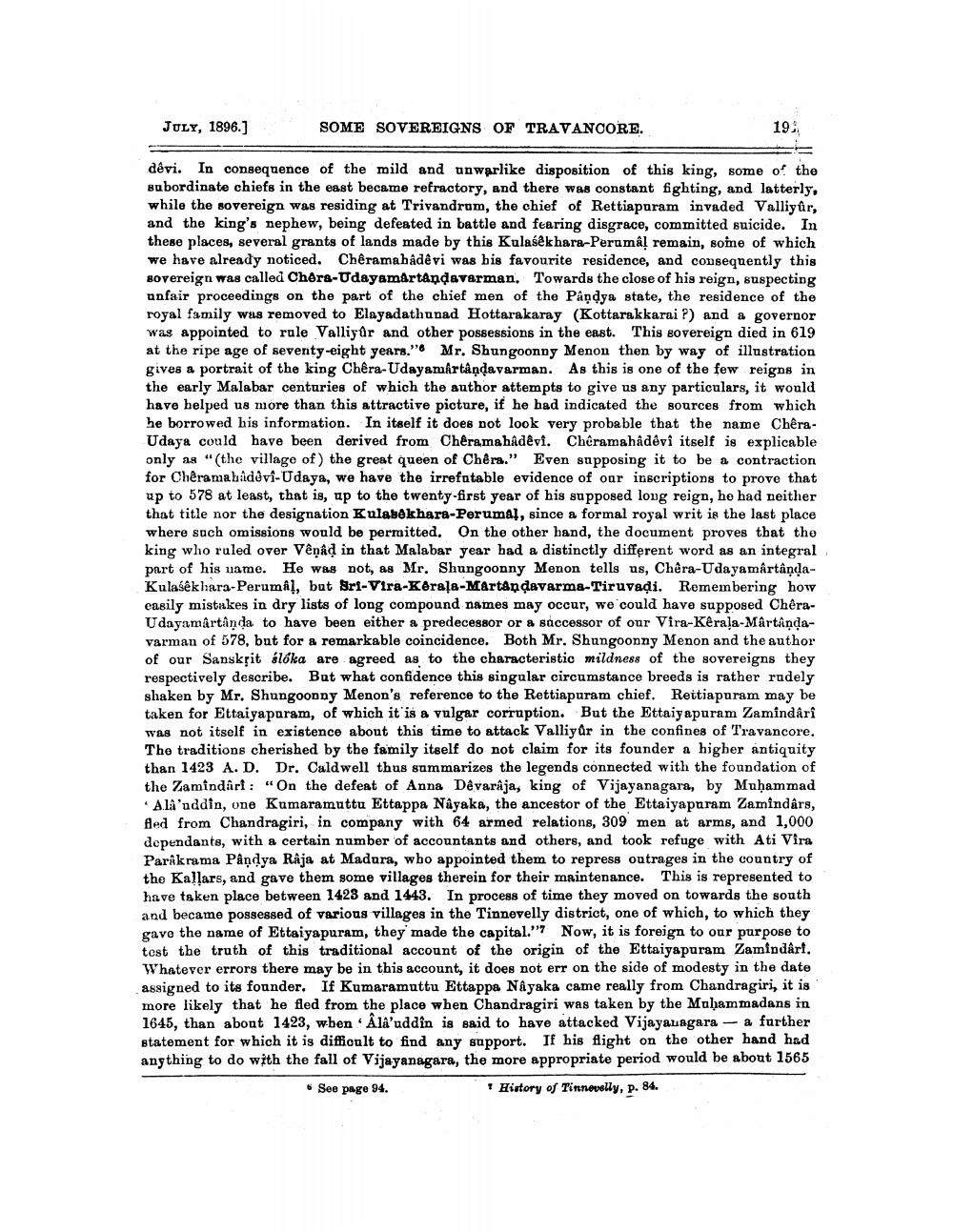________________
JULY, 1896.]
SOME SOVEREIGNS OF TRAVANCORE.
19
dévi. In consequence of the mild and unwarlike disposition of this king, some o? the subordinate chiefs in the east became refractory, and there was constant fighting, and latterly, while the sovereign was residing at Trivandrum, the chief of Rettiapuram invaded Valliyûr, and the king's nephew, being defeated in battle and fearing disgrace, committed suicide. In these places, several grants of lands made by this Kulaśêk hara-Peruma! remain, soine of which we have already noticed. Chêramahadevi was his favourite residence, and consequently this sovereign was called Chora-Udayamartandavarman. Towards the close of his reign, suspecting unfair proceedings on the part of the chief men of the Pandya state, the residence of the royal family wus removed to Elayadathunad Hottarakaray (Kottarakkarai ?) and a governor was appointed to rule Valliyur and other possessions in the east. This sovereign died in 619 at the ripe age of seventy-eight years." Mr. Shungoonny Menon then by way of illustration gives a portrait of the king Chera-UdayamArtândavarman. As this is one of the few reigns in the early Malabar centuries of which the author attempts to give us any particulars, it would have belped us more than this attractive picture, if he had indicated the sources from which he borrowed his information. In itself it does not look very probable that the name CheraUdaya could have been derived from Chêrama hâdêvi. Chéramahadevi itself is explicable only as "(the village of the great queen of Chêra.” Even supposing it to be a contraction for Chêramabadovi-Udaya, we have the irrefutable evidence of our inscriptions to prove that up to 578 at least, that is, up to the twenty-first year of his supposed loug reign, he had neither that title nor the designation Kulabekhara-Perumal, since a formal royal writ is the last place where such omissions would be permitted. On the other hand, the document proves that the king who ruled over Vêņkd in that Malabar year had a distinctly different word as an integral part of his name. He was not, as Mr. Shungoonny Menon tells us, Chera-UdayamartandaKulasekhara-Perumal, but Sri-Vira-Kerala-Martåndavarma-Tiruvadi. Remembering how easily mistakes in dry lists of long compound names may occur, we could have supposed CheraUdayamártânda to have been either a predecessor or a successor of our Vira-Kerala-Mártandavarman of 578, but for a remarkable coincidence. Both Mr. Shungoonny Menon and the author of our Sanskrit ílóka are agreed as to the characteristic mildness of the sovereigns they respectively describe. But what confidence this singular circumstance breeds is rather rudely shaken by Mr. Shungoonny Menon's reference to the Rettiapuram chief. Reitiapuram may be taken for Ettaiyapuram, of which it is a vulgar corruption. But the Ettaiyapuram Zamindari was not itself in existence about this time to attack Valliyur in the confines of Travancore. The traditions cherished by the family itself do not claim for its founder a higher antiquity than 1423 A. D. Dr. Caldwell thus summarizes the legends connected with the foundation of the Zamindari : "On the defeat of Anna Devaraja, king of Vijayanagara, by Muhammad
All'uddin, one Kumaramuttu Ettappa Nayaka, the ancestor of the Ettaiyaparam Zamindars, Aed from Chandragiri, in company with 64 armed relations, 309 men at arms, and 1,000 dependants, with a certain number of accountants and others, and took refuge with Ati Vira Parkkrama Pândya Raja at Madura, who appointed them to repress outrages in the country of the Kallars, and gave them some villages therein for their maintenance. This is represented to have taken place between 1423 and 1443. In process of time they moved on towards the south and became possessed of various villages in the Tinnevelly district, one of which, to which they gave the name of Ettaiyapuram, they made the capital." Now, it is foreign to our purpose to test the truth of this traditional account of the origin of the Ettaiyapuram Zamindari. Whatever errors there may be in this account, it does not err on the side of modesty in the date assigned to its founder. If Kumaramuttu Ettappa Nayaka came really from Chandragiri, it is more likely that he fled from the place when Chandragiri was taken by the Muhammadans in 1645, than about 1423, wben Åla'uddîn is said to have attacked Vijayanagara - a further statement for which it is difficult to find any support. If his flight on the other hand had anything to do with the fall of Vijayanagara, the more appropriate period would be about 1565 • See page 94.
+ History of Tinnovelly, p. 84.




